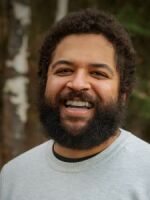Alaska’s Mat-Su Borough has been the fastest growing region of the state for years, but the amount of steady media coverage hasn’t kept up with that growth.
The founder of a new nonprofit news outlet is hoping to change that. Amy Bushatz is the reporter and editor of the Mat-Su Sentinel, an online news platform aimed at providing local news to an area the size of West Virginia, with a population of roughly 110,000 people.
Bushatz says her goal is to help connect residents with their local governments, and to hold public officials accountable.
Listen:
This interview has been lightly edited for length and clarity.
Amy Bushatz: I'm a junkie for local news. And so last May, I was looking around and I thought, you know, we don't really have consistent government news coverage in the Valley. And I really wanted to be a part of providing that because I believe local news is a public service. Clear, consistent, connect-the-dots reporting that simply helps folks understand what's going on in their local world is, in my view, a public service. And so I left my role at military.com to work on starting the Mat-Su Sentinel. The ADN was really wonderful, and let me work as their beat reporter out here in the Mat-Su starting in August. I did that through the end of this May, while I developed what I was going to do in the Mat-Su Sentinel, and then I left that and have launched the website.
Wesley Early: Can you describe why covering the Mat-Su area really matters now, maybe more than any time in the past?
AB: Sure, of course. The Mat-Su is not only the fastest growing part of the state, we hear that a lot, but recent statistics show it's the only growing part of the state. And that's people moving from Outside, that's people moving from other parts of Alaska, Anchorage for example, into Mat-Su. And so we have a population here that is here, they're growing, they need to know what's going on. There are also really important things happening here to meet the demand of that growing population. It is a challenge to be a rural community in a rural state and then have a situation where, all of a sudden, you have more people than you were ever expected to have. I mean, if we look back over the decades, this would, I think, be a surprise to folks. And the way your government is set up does not necessarily meet the service needs of those populations. And the government has to figure that out.
And that's something that's really important for reporters to be a part of, because if we do not report on what government officials are doing — these are people we've entrusted to shepherd our government and to make laws for ourselves and to set tax rates and all of those things — if a reporter is not watching that, then those folks are just doing their job. And we're just assuming that they're doing it in a way that the citizens and residents like myself are in support of. And whether you support it or not is not the point. The point is knowing what's happening so that you can make a decision and keep those folks accountable, that they're doing what they said they're going to do, or they're doing things that reflect your value system. News is not here to tell you what to do. It's to inform you of what's happening so that you can decide that for yourself.
WE: You mentioned you've already got a couple of stories in the can over the last week. What are some growing news topics in the Mat-Su that you're planning on tackling?
AB: Schools are a hot topic. Anything that touches on development is a hot topic because we are growing and there are growing pains with housing and, you know, do we want or need zoning? How are our roads being changed to deal with that increase in traffic?
And then the other topic that I have not reported on but certainly will come up probably sooner than later is public safety here in the Valley. The borough does not have police powers. We have a police force in Palmer, there is a police force in Wasilla. The borough has the ability to have a police force but does not have one. And therefore the region relies on policing and public safety from the Alaska State Troopers. This is a challenge because there are five to six Alaska State Troopers, that the Department of Public Safety has told me, patrolling the Mat-Su, which is an area the size of West Virginia, at any given time. And you can imagine if there's something going down way down KGB (Knik Goose Bay Road) or up in Talkeetna, that's troopers who aren't patrolling down in the rest of the area, outside of those cities where the city police force are. And so it creates a public safety challenge, to put it lightly. And the borough is really starting to think about tackling that. It's been a topic at Assembly meetings recently: How do we provide public safety for our residents, while also not spending all of our money on creating a police force? It's a real push-pull, a real tension right now.
Editor's note : Amy Bushatz is one of Alaska Public Media's hosts of Outdoor Explorer.


